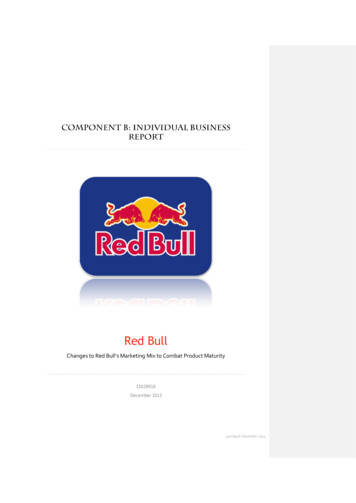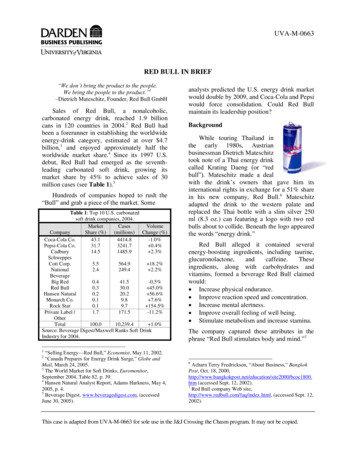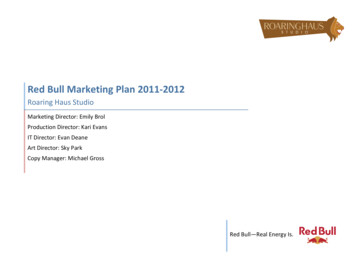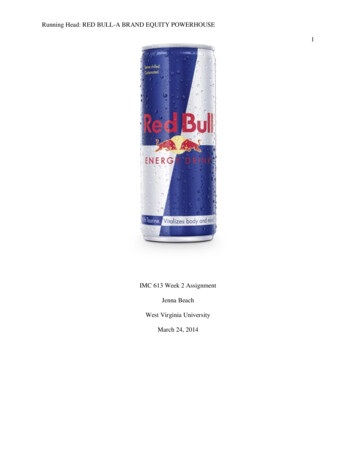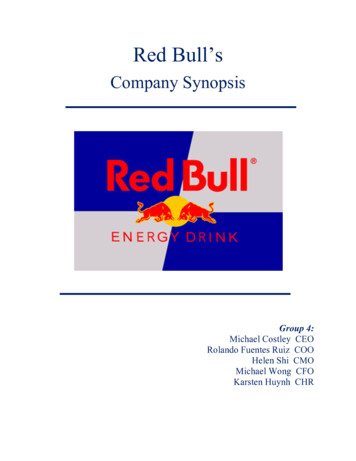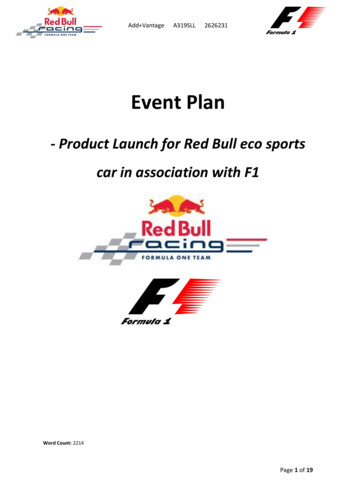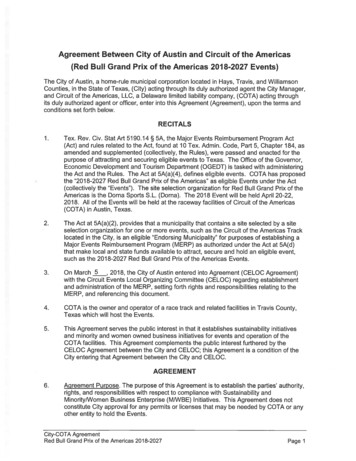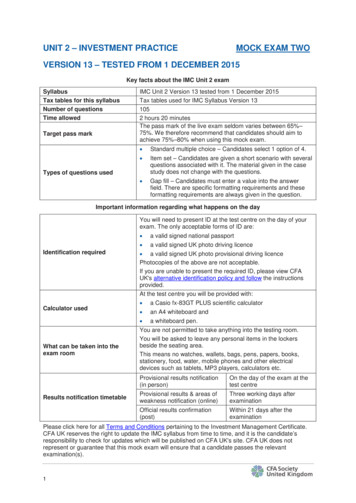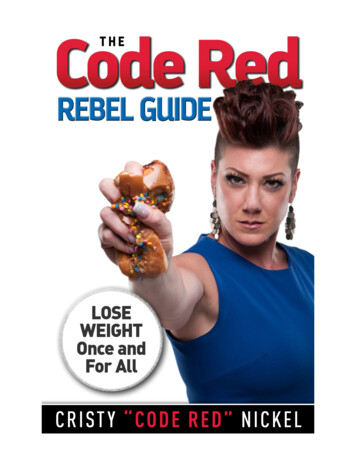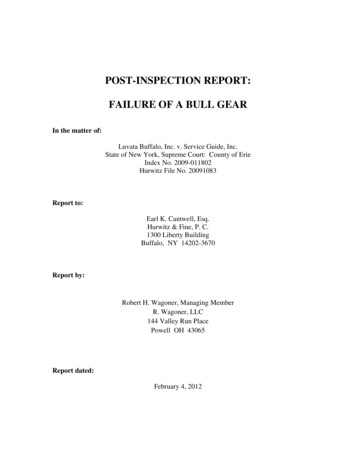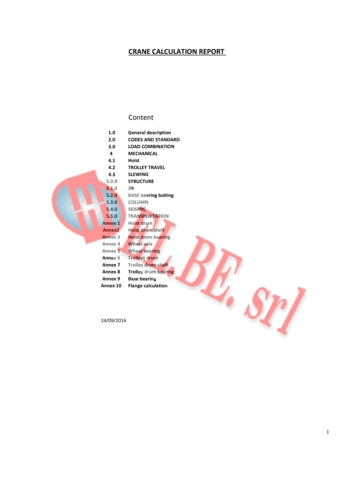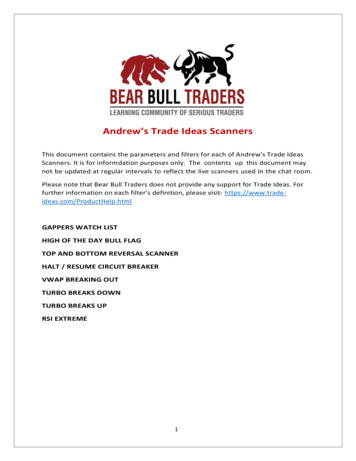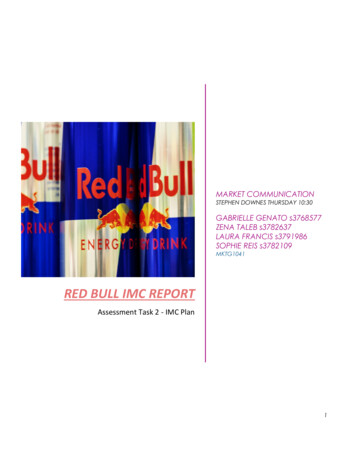
Transcription
MARKET COMMUNICATIONSTEPHEN DOWNES THURSDAY 10:30GABRIELLE GENATO s3768577ZENA TALEB s3782637LAURA FRANCIS s3791986SOPHIE REIS s3782109MKTG1041RED BULL IMC REPORTAssessment Task 2 - IMC Plan1
RED BULL ENERGY DRINK (250ML)Marketing Communications MKTG1041
RED BULL ENERGY DRINK (250ML)1.0 EXECUTIVE SUMMARYThis report outlines the way in which Red Bull energy drink 250ml can will run an Integrated MarketingCommunications (IMC) plan for 4 weeks. The objectives of it being to analyse the company and produceeffective communication strategies that will create a successful campaign for Red Bull. The first part of thisreport outlines the background research and analysis; including Internal research, External research,SWOT analysis and key strategic decisions. The second part of the report will exhibit the IMC plan decisionsand strategies; including creative, communication, and media strategies.Whilst Red Bull is an Austrian brand, it is one of the most popular energy drinks in Australia and has thelargest market share in the energy drinks market. Red Bull is infamous for its risky stunts and sponsorshipof thrill seekers, including top athletes, sporting events and teams, around the world. Red Bull has areputation for giving you the energy to do everyday activities or the riskiest of activities.In this report, the IMC plan outlines the proposed Valentine’s Day energy drink to give singles the energyto find love and start dating. This campaign will be executed in conjunction with popular Australian datingapps such as Tinder and will have match-making events in collaboration with radio stations such as Fox FMto promote the Red Bull energy drink.The aim of this IMC plan is to ultimately increase Red Bull’s market share by 10% and overall brandawareness in Australia. This will be done using both traditional media (TV, radio, magazines, andbillboards), as well as through new media (social media, dating apps and the internet). Mock-up conceptsfor these media platforms can be seen throughout the report.Marketing Communications MKTG1041
RED BULL ENERGY DRINK (250ML)2.0 CURRENT SITUATION ANALYSIS2.1 BACKGROUND RESEARCH ANALYSISInternalRed Bull is a brand that offers a variety of energy drinks with a unique marketing concept that wasdeveloped in 1984 by Dietrich Mateschitz in Austria. The founding of Red Bull created the new productcategory ‘energy drinks’, which today is a billion-dollar industry, with their headquarters located in Fuschlam See, Austria. Their infamous slogan ‘Red Bull gives you wiiings’ symbolizes the stimulating propertiesof the energy drink and is recognized worldwide by consumers, displaying the success of one of itstrademark taglines to create an association between hearing that slogan and the product/brand.Red Bull is a global brand having launched in 171 countries including The United States, Brazil, India, andAustralia, and currently employs 12,700 people around the world. Initially, one of Red Bull’s very firstmarketing campaigns was giving out free cases of the energy drink to college students in an attempt atviral advertising, which was a huge success and resulted in an increase in sales and brand awarenessamongst college students needing a pick me up. Red Bull has a very specific target market which consistspredominantly of thrill seekers including top athletes, students, busy professionals, and traveller’s on longjourneys (Red Bull Energy Drink, 2020) all of whom desire to have an energy kick.Since their first campaign, Red Bull has adopted a very unique and sleek approach to marketing its productsand has rather generated its brand awareness through successful marketing campaigns that includesponsoring extreme sporting events such as the Red Bull Air Race, Red Bull Cliff Diving World Series, RedBull Formula 1 Racing, and its most infamous stunt; the Stratos Space Diving Project. All of which createdawareness of the energy drink brand through these extreme events, and the sponsoring of top athletes,sporting teams, and thrill seekers. Red Bull has adopted a sleek marketing approach by selling their brandbut not having to push it (Breonna Bergstrom, 2017). Red Bull’s logo is always a prominent feature at theseevents to assist in creating brand awareness and have created an association between the brand andextreme events. This demonstrates Red Bull’s capability to implement successful IMC programs.However, a weakness in Red Bull’s marketing is its failure to launch in Denmark and Norway, as theirproducts are banned in these countries. This is a flaw in Red Bull’s inability to adapt to these countries'Marketing Communications MKTG1041
RED BULL ENERGY DRINK (250ML)regulations and thus not allowing them to penetrate the market due to health concerns. Unfortunately forRed Bull, this demonstrates a failure in successfully attempting to implement an IMC programme in thesecountries.Red Bull has created an iconic image for itself with the face of the company being their tall silver-blue canbeing highly identifiable amongst competitors, whilst the Red Bull emblem is also a globally recognizablebrand depicting two red bulls butting heads in front of a yellow circle, which some interpret to be the sun(1000 logos, 2019).In terms of brand image, traditionally Red Bull is aimed at thrill seekers and has been known to sponsorlarge sporting events, teams, and festivals. However, due to the proposed marketing campaign in this IMCreport, the target market is young single people in Australia and creates an image association of datingand Red Bull.In terms of sales and profitability, Red Bull currently has the largest market share for energy drinks aroundthe world, although it does not disclose the figure due to Red Bull GmbH being a private company.However, Red Bull saw 7.5 billion cans sold in the 2019 financial year leading group sales to grow by 9.5%to 6.067 billion Euros. Red Bull also saw record figures in its sales quantity, turnover, productivity, andoperating profit (Red Bull, 2020) in the history of the company. Red Bull has seen their recent sales, profitand market share trends all experience an overall increase in growth globally.Red Bull is known for its ambitious and risky approach to business operations by sponsoring major sportingand extreme events, as well as top athletes, festivals and its music label, Red Bull Records. Given this, RedBull’s mission is to promote its brand through these events without the push to explicitly sell the actualproduct, creating a unique marketing strategy. The company culture is youthful with a focus on anenergetic, playful business workplace attitude that will hopefully reflect in the consumers they attract,therefore, resulting in the successfulness of the campaigns as their business and consumers have similarphilosophies.Marketing Communications MKTG1041
RED BULL ENERGY DRINK (250ML)ExternalThe external environment are those factors physical and social that affect an organization outside of thebusiness. These factors include political, economic, socio-cultural, technological, legal, environmental, anddemographic. Red Bull is affected by all these factors in one way or another, so thorough analysis can beused to assist in decision making and improving the business.Macro environmental factorsPoliticalIt’s not a healthy option unless you get the sugar free but even then, it’s got no nutritional value. Has posed domeserious health risks and it was previously pulled from the market in Germany after it was found to have cocaine init. However, the government decided it was not a risk as it was so small you would have to drink 12,000 litres tofeel the effects.EconomicalCoronavirus has created great strain on the economy and thus has affected most people’s disposable income.More commonly than not, reducing their ability to make purchases such as red bull. There has been a lot of loss ofincome resulting in people needing to vastly cut back on want costs and focus solely on need costs.Socio-culturalThe people typically concerned with fitness and health are not the target audience or consumers of Red Bullproducts. It is often viewed as a young person's drink but otherwise there aren’t any cultural barriers for theproduct. Socially it is a matter of preference.TechnologicalRed Bull has kept up to date with ‘green’ technology and are doing their part to be sustainable. They do this withthe eco coolers so as to reduce their carbon footprint as well as by recycling their cans and using the recycled cansrepeatedly.EnvironmentalFrom an environmental aspect our impact is low enough to not be problematic as we do not use plastic bottles,just cans. Not only that but there is a sustainability section on the website that discusses the lifecycle of their cansas well as a detailed yet easy to understand (with the use of cartoons) CSR report (Corporate Social Responsibility).Red Bull is constantly looking for more ways they can be sustainable but now they are limited with the capabilitiesof the technology.LegalRed Bull needs to understand any regulations or restrictions the Australian government has in terms ofadvertisement.Red Bull is a private company with no stock available for purchase on the stock market.DemographicRed Bull is now targeting Single Australians between the ages of 24-35. In such a multicultural and diverse countrythis demographic cannot be reduced to any other similarity then they are looking for love.Marketing Communications MKTG1041
RED BULL ENERGY DRINK (250ML)Competitive analysisMonster is Red Bull’s biggest competitor, with Rockstar, Mother and V as potential rivals. There are ofcourse many other energy drink brands, but they are not listed here as they do not have any sort ofcompetitive advantage or popularity and are therefore not considered to be Red Bull’s competitors. Ofthese competitors V is the only other energy drink that focuses more on energy then adrenaline and theyhave light, amusing and simple ads, much like Red Bull. However, Red Bull is a more established brandwith greater brand recognition. There are no other energy drinks in the market that are advertising forconsumers to find love which differentiates Red Bull from competitors, and, as the campaign is creating asingles event in Australia, which has an abundance of single people looking for companionship, it iscornering the market as well as expanding its consumer base to all single people between the ages of 24and 35. Monster also promotes and sponsors extreme ‘sporting’ events, similar, but not the same as RedBull does. The things they sponsor are BMX, motocross, mountain biking, snowboarding, skateboarding,car racing, speedway, as well as e-sport events. The main difference is that Red Bull sponsors more activitysports then just adrenaline inducing (and highly dangerous) events. Not only sporting and other events,but Red Bull did the Mission to the Moon in 2018, in which they sent someone to the moon (Roxborough,2018). The constant above and beyond advertisement techniques of Red Bull in the past will help to keepthe previous target audience of young males interested in extreme sports, whilst also expanding to includesingle people looking for love (Puzzle, 2020).Consumer behaviour analysisThe consumer behaviour for the new target market of single Australians aged 24-35 is different from theusual teenager to young adult males and people interested in extreme sports. This means that Red Bull istargeting a completely new demographic and must adjust marketing tactics accordingly. There is a severelack of dating culture in Australia and men and women often follow a pack mentality (Croffey, 2016). Thispack mentality sees that mingling is very rare, which is causing a problem of people being unable to meetpeople from the opposite sex, while people interested in same sex relationships may find it a bit easierwhen they are already in the gender group with potential love interests. Surveys have shown thatAustralians admit to finding it hard to meet others for the purposes of romance (Croffey, 2016). Tinder isMarketing Communications MKTG1041
RED BULL ENERGY DRINK (250ML)very popular with Young Australians looking to find love as well as other dating sites like eHarmony, zoosk,elite singles, match, rsvp, naughty date, gays tryst and gay men go dating. This shows that there has beena huge movement in the last few years to online dating then relying on stumbling into someone on thestreet or at work (IBIS World, 2019). This trend in dating online also shows that Australians are activelytrying to find companionship and are probably willing to go to an event to help meet other single people.Australians often consume Red Bull in night clubs as well as at festivals and sporting events. And as roadtrips around Australia are popular, especially around Christmas, Red Bull is consumed to keep peopleawake, alert and adequately refreshed while driving. However, it is events that make Red Bull so successfulwhich is why this campaign includes a dating event.Current Brand Item EvaluationThe Red Bull 250ml can, can be found in any 7/11, petrol station, Woolworths, and Coles around Australiaat any given time. It can also be found in most cafes, bakeries, and vending machines. This means that theproduct is constantly and readily available for consumption. Red Bull is being constantly advertised in itsmany sponsorships that span the year. It is currently the leading energy drink in Australia according toconsumers (Eruomonitor, 2020).2.2 SWOT:Conducting a SWOT analysis is important for Red Bull to evaluate the company's internal strengths andweaknesses along with external opportunities and threats that they are presented with.Strengths:-Red Bulls logo (red bull’s butting heads over yellowcircle) packaging (blue and silver) makes the producteasily recognizable which assists in creating brandawareness-Being highly distinguishable represents high quality ofdrink-Globally recognizable brand-Red Bull currently has the largest
Red Bull has adopted a sleek marketing approach by selling their brand but not having to push it (Breonna Bergstrom, 2017). Red Bull’s logo is always a prominent feature at these events to assist in creating brand awareness and have created an association between the brand and extreme events. This demonstrates Red Bull’s capability to implement successful IMC programs. However, a weakness .
